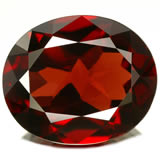Rhodolite Garnet: The Rose-Red Gemstone

Introduction to Rhodolite Garnet
Picture a gem that glows like a raspberry or blooms with a soft rose-pink hue-that’s rhodolite garnet! This captivating gemstone, a blend of pyrope and almandine garnets, gets its name from the Greek word "rhodon," meaning "rose-colored." Its vibrant hues make it a favorite among gem lovers. The term "garnet" itself harks back to the Medieval Latin "granatum," meaning "dark-red," possibly inspired by the deep red of pomegranate seeds. Want to see some stunning examples? Browse our rhodolite garnet collection at GemSelect.
Rhodolite’s history stretches back thousands of years. Egyptian pharaohs adorned themselves with garnets for ceremonial and decorative purposes, while ancient Romans flashed garnet rings and traded these gems across empires. Back then, red garnets were often called "carbuncles"-not exactly a glamorous name, since it also meant boils! Thankfully, we now appreciate rhodolite for its vivid raspberry-red or purplish-pink shades, making it a timeless choice for jewelry.
For a full overview of garnet history, species, and properties, check out our Garnet Gemstone Information page.
Identifying Rhodolite Garnet
How do you spot a rhodolite garnet? Look for its signature rose-pink to raspberry-red color, which sets it apart from the deeper reds of other garnets. As a mix of pyrope and almandine, it shares traits with both but leans toward purplish or pinkish tones. You can also identify it by its occurrence in metamorphic rock, its hardness (6.5–7.5 on the Mohs scale), and its cubic crystal structure. Here’s a neat trick: rhodolite is attracted to strong neodymium magnets due to its iron or manganese content, making it stand out from other gems.

For a broader introduction to all types of garnets, visit All About Garnet.
Sources of Rhodolite Garnet
Rhodolite garnet is mined across the globe, from Brazil and Burma (Myanmar) to China, Kenya, Madagascar, Mozambique, Sri Lanka, South Africa, Tanzania, the USA, and Zimbabwe. Each source contributes to the gem’s availability, with no single region dominating the market. Whether you’re hunting for a vibrant piece or just curious about its origins, rhodolite’s global reach ensures plenty of options.
Buying Rhodolite Garnet
Color
Rhodolite shines in rose-pink, purplish-pink, or raspberry-red hues. The raspberry-red shade is the most sought-after, so aim for that vibrant pop if you want the best!
Clarity and Luster
Top-quality rhodolite garnets are eye-clean, meaning no visible inclusions. Their vitreous luster and high refractive index give them a brilliant sparkle that’s hard to miss.
Cut and Shape
Rhodolite is versatile, often faceted to maximize its brilliance or cut into cabochons for a smoother look. You’ll find it in various shapes, from ovals to rounds.
Treatment
Good news: rhodolite garnets are typically untreated, so you’re getting a natural gem. Just watch out for fakes when shopping for premium stones.
Check out our Garnet Buying Guide for expert tips on selecting rhodolite or other garnets.
Gemological Properties
| Chemical Formula | Pyrope: Mg4Al2(SiO4)3 Magnesium aluminum silicate; Almandine: Fe3Al2(SiO4)3 Iron aluminum silicate |
| Crystal Structure | Cubic, rhombic dodecahedron, icositetrahedron |
| Color | Red, purplish-red, pink, pinkish-red |
| Hardness | 6.5 to 7.5 on the Mohs scale |
| Refractive Index | Pyrope: 1.720 - 1.756; Almandine: 1.770 - 1.820 |
| Density | Pyrope: 3.62 - 3.87; Almandine: 3.93 - 4.30 |
| Cleavage | Indistinct |
| Transparency | Transparent to opaque |
| Double Refraction | Usually none |
| Luster | Vitreous |
| Fluorescence | Mainly none |
For more gemology terms, check out our Gemstone Glossary.
Mythology and Symbolism
Garnets have a legendary reputation as travelers’ stones-rumor has it Noah used a garnet lantern to guide the Ark through the night! In Hindu traditions, rhodolite is linked to the root chakra, promoting healthy sexuality, security, and stability. It’s also believed to boost circulation, self-confidence, and business success. As January’s birthstone and Aquarius’ zodiac stone, rhodolite carries serious symbolic weight. Just don’t expect it to replace your doctor’s advice-see the disclaimer below!
Learn more about the traditional symbolism and spiritual powers of garnet in our Garnet Meaning and Powers article.
Jewelry Design Ideas
Rhodolite garnet is a jewelry designer’s dream, perfect for rings, necklaces, pendants, bracelets, or even hairpins. Set it in silver to highlight its purple tones or gold to enhance its rosy glow. Mix it with clear gems like white sapphire or colorful ones like topaz or peridot for a modern twist. Its durability (6.5–7.5 Mohs) makes it ideal for daily wear, and its rich color suits both men’s and women’s jewelry-though it’s a particular hit in ladies’ designs. Pro tip: Buy by size, not carat weight, as colored gems vary in density compared to diamonds.
Famous Rhodolite Garnets
Rhodolite has dazzled in iconic jewelry pieces. In the 19th century, Russian jeweler Faberge crafted stunning brooches using rhodolite, gold, diamonds, and rubies. Around 1900, Tiffany’s Paulding Farnham designed an intricate iris flower brooch with rhodolite and demantoid garnets. Modern jeweler JAR, known for his floral designs, has also featured rhodolite in exquisite pieces. In 2012, actress Sanaa Lathan rocked rhodolite, pink sapphire, and vanilla diamond earrings by Le Vian at the NAACP Image Awards.
Care and Cleaning

Rhodolite garnets are tough, but they need a little TLC. Protect them from hard knocks that could cause damage. Clean them with warm soapy water and a soft cloth, rinsing thoroughly to remove residue. Skip ultrasonic cleaners or steamers, and avoid sudden temperature changes. When storing, wrap rhodolite in a soft cloth or place it in a fabric-lined jewelry box to prevent scratches from other gems.


